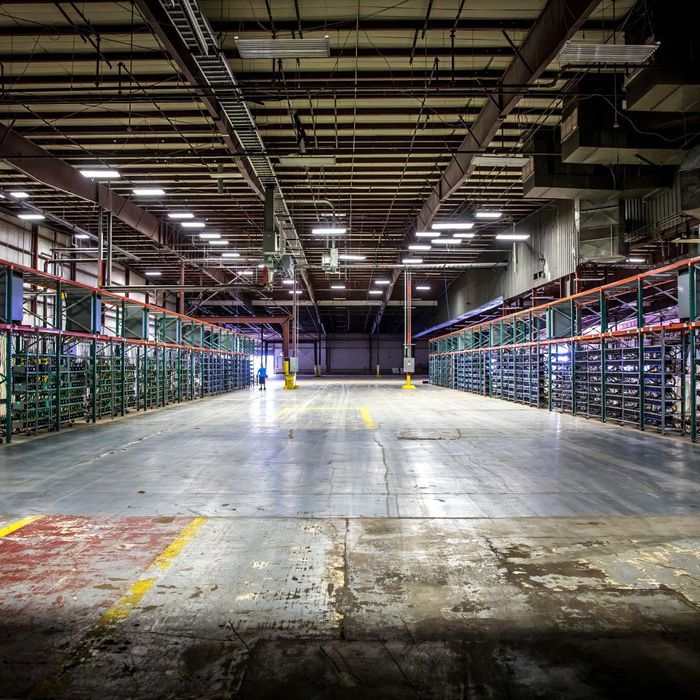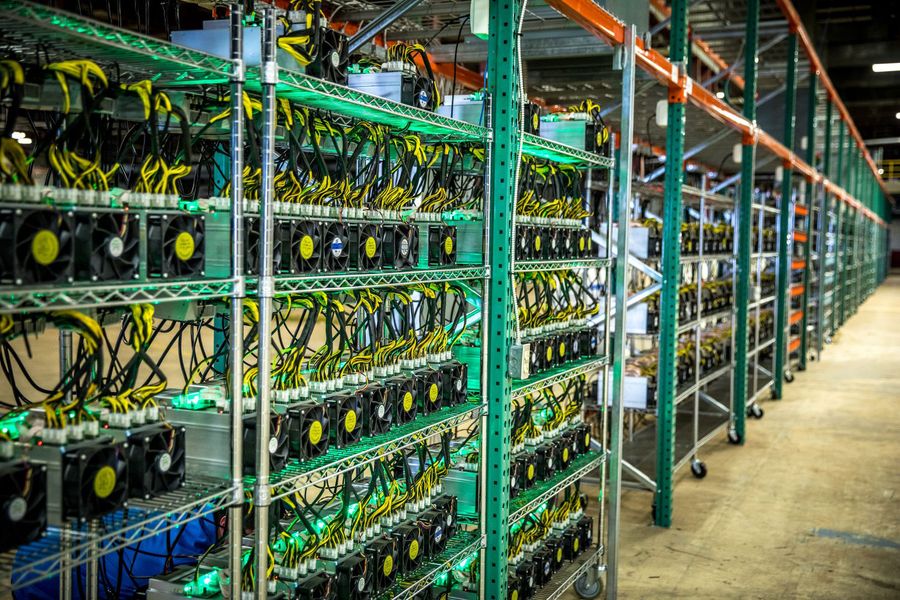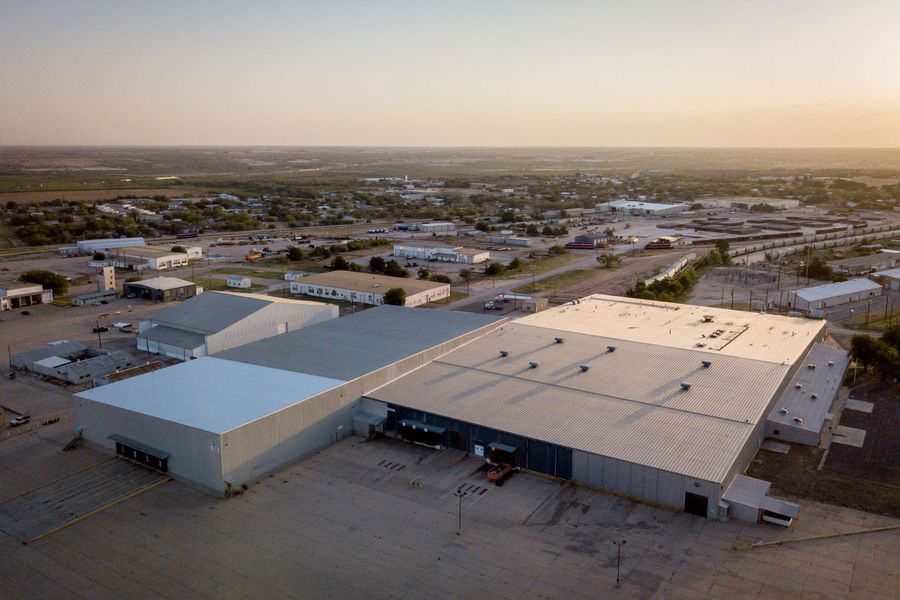[ad_1]

A World War II–era airplane hangar in Texas has been converted into a bitcoin mine.
Photo: Courtesy of Compute North
Nestled in the Appalachian Mountains near Marble, North Carolina, there’s a 250,000-square-foot factory building that used to make denim for Levi’s jeans. Starting in the 1960s, Levi Strauss built many plants like this across the American South — and then shuttered almost all of them in the 1990s and early 2000s, when it moved its manufacturing operations overseas. After this North Carolina factory closed in 1999, the building, which sits on 70 acres of land, stood empty for almost two decades. Then the crypto miners came to town.
In 2017, Darin Feinstein had just founded Core Scientific, which is now the one of largest crypto-mining companies in North America. At the time, the company was just getting ready to open its first facility, and Feinstein said they looked at more than 500 sites trying to find everything on a very particular wish list. First and foremost, they were looking for an inexpensive power source for the energy-intensive process of mining, which meant a more rural location, as electricity tends to be cheaper farther from major cities. Ideally, they would also find existing infrastructure that could be converted for the mine’s purposes: a large empty building that could be filled with shoebox-size computers, vents that could be used for thermodynamic cooling, and land for potential expansion.
In the abandoned Levi’s factory, Feinstein found all of the above. The sprawling building would fit plenty of computers, but the main selling point was proximity to a series of hydroelectric dams. They had helped power the factory but have been used much less since Levi’s left town. This kind of “stranded power,” or a dormant energy facility with all the infrastructure already in place, is exactly what miners are looking for. So Core Scientific bought the old denim mill and filled it with computers, which have been whirring away constantly ever since, “mining” new bitcoin, litecoin, ethereum, and monero with each complex math problem they solve.
In the last year, cryptocurrencies like these have hit wildly high prices on crypto exchanges, leading to a craze that has spawned a host of new currencies, and given rise to feverish speculation on blockchain-backed NFTs. The high prices have also led to a boom in mining operations — and a hot new real-estate market for former industrial spaces to convert into mining facilities. “We’ve produced enough machines now” to meet the demand for new crypto mines, said Mike Colyer, CEO of Foundry, a mining outfit that provides equipment financing and advisory services to other miners. “But people don’t have anywhere to plug them in.”
Many former factories are owned by private real-estate developers, who bought them up on the cheap when manufacturing left — and are now reselling them for a profit. “We’re getting phone calls from people even in New Hampshire and Vermont, from someone who might own a paper mill that went out of business, who’ll say, ‘I’ve got a paper mill and nobody else wants to come up here, so can I put in a bitcoin-mining facility?’” Coyler said.
Many crypto miners are looking for their version of what Feinstein found in North Carolina: unused factories, cheap land, and industrial infrastructure that can be easily repurposed. Ex-manufacturing spaces are particularly attractive because the industrial processes have something in common with mining. “You need to get a lot of air into the building and a lot of air out of the building, so typically you’d open up the side walls and vent it through the roof,” Colyer said. “That’s why certain places like the old Alcoa factories are some of the most popular, because they’re very large buildings with a lot of installed electrical infrastructure, and the buildings were designed to remove heat, so they become natural places for mining.”
It’s not just denim mills and aluminum smelters. Around the country, mining operations have cropped up in an ex-steel mill in Calvert City, Kentucky; an ex-Gateway Computer industrial campus in South Dakota; a power plant in Hardin, Montana; a former airplane hangar in Big Spring, Texas; and old fruit warehouses in Eastern Washington State. The hulking abandoned palimpsests of American industry are, almost overnight, turning back on.
Computers work constantly to solve complex equations to “mine” new crypto coins — using a lot of energy in the process.
Photo: Courtesy of Compute North
But not all residents and local officials have jumped to embrace the crypto-mining gold rush. There are concerns about power costs and energy consumption, and anxiety over what other ills could come with the industry scaling up so quickly. These worries are not entirely new: Eastern Washington became the epicenter of U.S.-based mining in 2018, during the last bitcoin bubble, and after months of feverish speculation, a number of towns and counties put moratoriums on new operations.
Now, some elected officials and residents in New York are wary of crypto-mining too. There are now at least two major mining operations in the Finger Lakes region, another epicenter of low-cost energy thanks to local hydropower facilities. One, Greenidge Generation, opened in 2020 in an old power plant that was originally coal-fired but was converted to natural gas in 2017. Another runs out of one of those sought-after Alcoa smelters in Massena, N.Y. In early May, some state legislators became worried that the mines and their emissions could worsen the climate crisis. State assemblywoman Anna Kelles authored a bill that would have put a three-year moratorium on new mining facilities in the state, along with a requirement for state-run environmental-impact assessment for future mines. Residents are worried too: In early June, WRFI Community Radio reported, 200 people rallied at the regional headquarters of the New York State Department of Environmental Conservation in protest of Greenidge. “There’s nothing green about Greenidge,” one sign read.
Some of their concerns are highly specific, local environmental problems related to the Greenidge plant, like the potential warming of Seneca Lake, where water heated during the mining process is being put back into the lake at high temperatures. But they’re also accompanied by broader concerns about the carbon emissions and energy use associated with blockchain; by one estimate, bitcoin as a whole consumes more electricity annually than Austria. Though Greenidge and many other mining companies have purchased carbon offsets to become carbon-neutral, critics say that this doesn’t factor in the opportunity costs — after all, we can’t simply offset everything.
Kelles is also worried that there will be more mines opening. “If you look at the list of mothballed power plants, they’re in Queens, Suffolk County, all over the Finger Lakes, and all over Long Island,” she said. “Not all of them would have the infrastructure to be cryptocurrency mining facilities, but there’s potential there.”
The moratorium bill failed in the state assembly in June, and more mining operations are indeed coming to New York: In March, a company called Digihost bought a 60-megawatt natural-gas-powered plant north of Buffalo for $3.5 million, with plans to turn it into a bitcoin mine.
Crypto mines have moved into a variety of old industrial spaces, including this World War II–era hangar.
Photo: Courtesy of Compute North
Despite concerns raised by lawmakers and environmental groups, many states are eager to attract miners. North Dakota and Wyoming both passed laws that give tax breaks to oil producers that provide gas to crypto mines that would have otherwise flared. The governor of Kentucky recently passed a tax break for any miners coming into the state. And the governor of Texas, Greg Abbott, recently signed a law that recognizes the legal status of cryptocurrencies and the rights of those who hold them. The message from these red-leaning states: Crypto miners are welcome here.
Compute North, which specializes in developing spaces for crypto miners, already has a facility in Texas, based in a former World War II airplane hangar, and CEO Dave Perrill said that many of the projects currently in development are in Texas, which is one of the most crypto-mining-friendly states in terms of low-cost and stranded power. Compute North has other centers up and running in South Dakota and Nebraska too, and 40 more sites are currently in some stage of the development process.
Still, there are obstacles for crypto miners — and at least in part because of how hot the real-estate market has become. Instead of looking for abandoned buildings, some customers are instead coming to Compute North for premade modular mining sites built in shipping containers that can be put anywhere near a source of cheap power. They’ve set up one such site in Kearney, Nebraska — a set of retrofitted shipping containers in the middle of an empty green field, whirring away.
But the race for post-industrial space is still on. Colyer said he is regularly getting multiple emails a day from miners who have equipment and are looking for advice on finding a place to put it. He said, “Everyone’s running around and looking at spaces and sites, asking, ‘How can we turn this into a bitcoin mining facility?’”
[ad_2]




